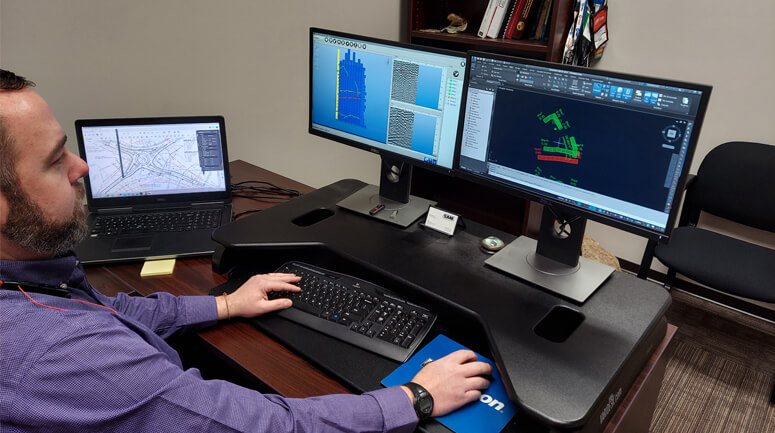Five Questions about SUE with Rhett Sloan
| Rhett Sloan

In the world of engineering and utility coordination, Subsurface Utility Engineering (SUE) is a fairly new concept. Though only decades old, the field is evolving rapidly with the use of new technology and techniques. SUE helps resolve issues related to unnecessary utility relocation, mitigates unexpected conflicts with utilities, and enhances safety. Proper SUE execution can help reduce project costs and avoid delays.
The American Society of Civil Engineers (ASCE) standard defines SUE as a process, not a technology and a core principle of the practice is the categorization of quality levels through degrees of risk related to the depth of information needed for projects. Quality levels range from Level A, the highest level of data, to Level D, the most basic level of data needed. SUE professionals act as consultants on projects large and small and must remain equipped with the latest standards and technologies to successfully deliver data for infrastructure projects.
With over 13 years of SUE experience, Rhett Sloan, a Senior Project Manager at SAM, offers valuable insight into the SUE industry and how technology combined with expertise is saving clients time and money. He leads a team of more than 10 members in SAM’s Youngstown, OH office specializing in Survey and SUE.
Q: What are the key benefits that SUE work delivers?
A: First and foremost, we deliver what is at the front of every client’s mind on a project, and that is an accurate depiction of where the underground utilities are located. In satisfying that need, we pride ourselves on providing much more than just the basic definitions and standards of ASCE 38-02. In most cases, we are able to identify not only the known utilities, but unknown utilities as well, which can be inactive or abandoned. This information is critical and is joined with the accurate utility designation to provide a complete picture. Quality Level D information is sometimes overlooked for its lack of definition, but is truly the foundation of the work to be performed in the field.
Secondly, following up with the utility companies to confirm our findings, whether we confirmed the record or found additional lines, this confirmation provides additional assurance to our clients. When speaking with utility companies we can obtain more information than just lines on a paper record or a JPEG image. We can also discover that repairs have been made periodically, which may mean that conditions are different than what is reflected on the record, or that the record is of the previous line and no one ever asbuilt the new line. All of this effort combined with the skillset of our SUE staff elevates our deliverable to be more conclusive and provides confidence to our client that we have done a thorough job.
Q: What advanced technology are you deploying on SUE projects, and how does it improve client deliverables?
A: Some of the technology we utilize is available to the industry as a whole, however, I believe that we implement it into our projects more frequently than other firms. Technology such as an EM-61 can help us collect data on buried metallic objects. Using this technology, we have discovered and collected data on unknown pipe fragments and underground storage tanks. These objects are more difficult to find with traditional pipe and cable locators, so having this technology keeps us ahead.
Another developing technology is the ability to collect Ground Penetrating Radar (GPR) data and convert it into a 3D map depicting underground utilities and objects. This allows us to take an existing technology, pair it with an advanced processing program, and provide a better interpretation of the data, which in turn offers an enhanced deliverable to our clients. It is also beneficial that we take existing methods of collecting data and increase the uses of the data by working with software developers and our in-house Applied Technology team to maximize what software platforms like Hexagon and IDS can do. We are constantly finding ways to keep technology new. As a company, SAM is pushing hard into researching and creating technology to build 3D models for Subsurface Utility Engineering projects.
Q: What other geospatial services do you work with frequently, and how does that increase value to clients?
A: Well, within SAM, we work the most often with our Geospatial and Survey departments. We work frequently in the transportation market, though more and more, we are working with electric utility clients and offering our services to our oil and gas clients as well. Having multiple disciplines in house really allows us to streamline data between departments and increase quality review. The access to these resources allows us to provide additional services with SUE, which allows our clients to reduce the number of sub-contractors on a team, have a single point of contact for multiple services, and have a streamlined process for data delivery.
Q: How do you stay ahead of new SUE standards and guidelines? For example, the ASCE standard guidelines.
A: Being involved in the SUE industry, participating in professional committees/societies, and having discussions with other SUE professionals around the country allow me to stay apprised of developments in standards and technologies. I enjoy reviewing this information and determining the best way to incorporate it into my workflow. When applicable, we review the changing standards with clients letting them know we are proactive and already moving towards the new standards and reviewing any cost implications as well as changes in deliverables.
Q: What do you do to keep your SUE team at the top of the industry?
A: Our field staff frequently reviews our current standard operating procedures to make sure they are efficient, and that the technology we use to collect field data accurately represents the same information to the office staff. We also encourage, and sometimes challenge, our field staff to utilize new technologies or methods on certain projects to better understand the capabilities of our technology.
SAM is also a large proponent of training and we apply that encouragement across our entire team. Our team works closely to conduct pilots and test new technology developed by our Applied Technology team. This not only helps us learn the benefits and limitations of our technology, it gives our team practice and stimulates new ideas to benefit clients.
Rhett is a Professional Land Surveyor registered in Georgia, Mississippi, Louisiana, Idaho, Pennsylvania, and South Dakota and is in the process of obtaining certification in Ohio. If you would like to learn more about SAM’s SUE services, reach out to Rhett Sloan at Rhett.sloan@sam.biz.
Rhett Sloan
Rhett Sloan, PLS, M.ASCE, is a SUE Department and Senior Project Manager primarily serving the Ohio area. He has held multiple roles developing and promoting the SUE industry, including serving as the 2022-2023 President for ASCE Akron Canton and on the SUE Association Board of Directors.
View Profile
